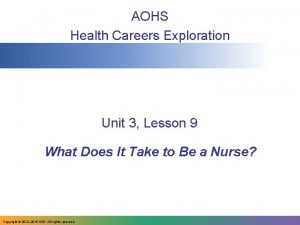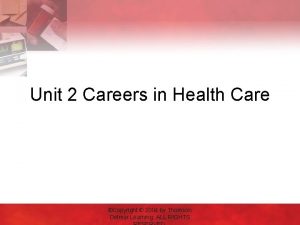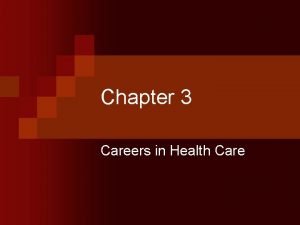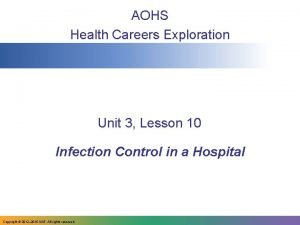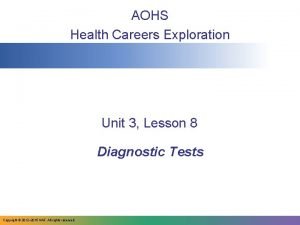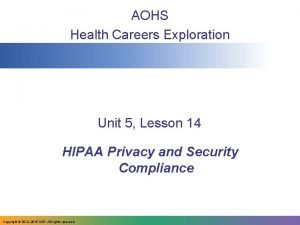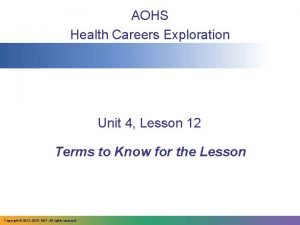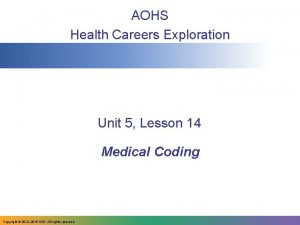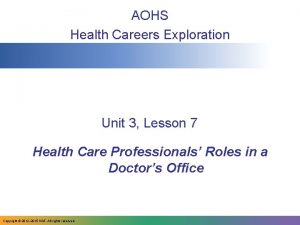AOHS Health Careers Exploration Unit 3 Lesson 10












- Slides: 12

AOHS Health Careers Exploration Unit 3, Lesson 10 Infection Control in a Hospital Copyright © 2012‒ 2015 NAF. All rights reserved.

The chain of infection enables disease to spread Agent Reservoir Susceptible Host Portal of Entry Portal of Exit Mode of Transmission

AGENT An agent is a pathogen that can cause disease Pathogen Bacteria Example Gastroenteritis Viruses Common cold Fungi Ring worm Parasites Tapeworms What other diseases do you know about that are caused by a bacteria, virus, fungi, or parasite?

A reservoir is the area where the agent lives • Humans and animals RESERVOIR • Birds and insects • Soil, water, and food • Table tops and doorknobs • Hospital equipment, like bedpan, linens, and needles Can you give other examples of likely reservoirs?

The portal of exit is where the agent leaves the reservoir • Blood PORTAL OF EXIT • Urine • Saliva • Draining wounds • Vomit Based on what you know about the portal of exit, what do you think the mode of transmission is?

The mode of transmission is the way that the pathogen is moved from one place to another MODE OF TRANSMISSION • Hands • Air • Insects • Clothing • Tissues • Surgical equipment Explain how a telephone receiver could be a mode of transmission.

The portal of entry is where the agent enters the susceptible host PORTAL OF ENTRY • Breaks in skin • Breaks in mucous membrane • Body orifices • Respiratory tract • Digestive tract What do you think is another portal of entry that is the same as the portal of exit?

The susceptible host is the person who is at risk for infection SUSCEPTIBLE HOST Whether or not the host gets sick depends on: • His immune system • The pathogen • The environment Why do you think hospital patients are hosts who are more susceptible than people who are not in a hospital?

Asepsis is the practice of preventing infection • Wearing gowns and facial masks; hand washing • Informing patients about hygiene • Changing linens appropriately • Using disposable gloves • Sterilizing equipment • Handling contaminated items appropriately What are other asepsis techniques that you know about? Do you think vaccinations are an asepsis practice?

Hand washing is the most important basic technique in breaking the chain of infection • Before and after every patient contact • When arriving and before leaving the hospital • Before applying and after removing gloves • After any contact with a soiled item • Any time gloves are torn or removed

How could Mario have broken the chain infection? of Agent: Bacteria Reservoir: Host: Portal of Entry: Portal of Exit: Mode of Transmission: As you listen to the scenario about this chain of infection, complete the boxes in this diagram. Then identify two places where Mario, the nurse, could have broken the chain of infection.

Breaking the chain of infection in hospitals protects patients and workers • The conditions that allow infection to spread are called the chain of infection. • Asepsis techniques break the chain of infection. • If any link in the chain is broken, infection will not occur. Why do you think that nurses play such an important role in breaking the chain of infection?
 Aohs health careers exploration
Aohs health careers exploration Unit 3 lesson 9 health science
Unit 3 lesson 9 health science Unit 2 careers in health care
Unit 2 careers in health care Aohs foundations of anatomy and physiology 1
Aohs foundations of anatomy and physiology 1 Aohs foundations of anatomy and physiology 1
Aohs foundations of anatomy and physiology 1 Aohs foundations of anatomy and physiology 1
Aohs foundations of anatomy and physiology 1 Aohs foundations of anatomy and physiology 1
Aohs foundations of anatomy and physiology 1 The speed at which the body consumes energy
The speed at which the body consumes energy Aohs foundations of anatomy and physiology 1
Aohs foundations of anatomy and physiology 1 The age of exploration lesson 1
The age of exploration lesson 1 Horizon nj health payer id
Horizon nj health payer id Chapter 4 careers in health care
Chapter 4 careers in health care Chapter 3 careers in health care
Chapter 3 careers in health care

